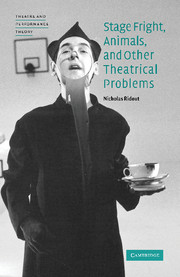2 - Embarrassment: the predicament of the audience
Published online by Cambridge University Press: 04 December 2009
Summary
Please don't look at me
In the Royal Shakespeare Company's 2000 production of Richard II Samuel West, who played Richard, addressed some of his lines directly to the audience. I know this because it happened to me. I cannot remember the line in question, nor the moment in the play when it happened, but I distinctly recall that it happened, and that I found it embarrassing. I know I shouldn't have done. When I was young and Brechtian I was all for eye contact. I wanted the theatrical encounter to be acknowledged. I wanted to do it with the lights on. I thought it would be more truthful that way. It made sense, it was rational, direct, and blindingly obvious. In the RSC production of Richard II, the lights are on and the actors talk to the audience.
As Bridget Escolme has argued in a recent book, this production ran against the grain of current mainstream practice in Shakespeare production in its use of direct address. Her work on direct address in Shakespeare and on this production in particular is enormously useful for the way in which it both accounts for and subjects to critique current production practice in this regard.
Direct address, at least in the modern theatre, in which the conventions of illusionism are firmly established, tends to signal some disjuncture between actor and role.
- Type
- Chapter
- Information
- Stage Fright, Animals, and Other Theatrical Problems , pp. 70 - 95Publisher: Cambridge University PressPrint publication year: 2006
- 2
- Cited by



